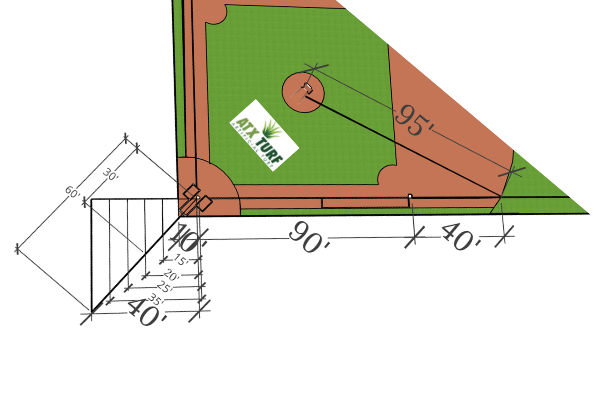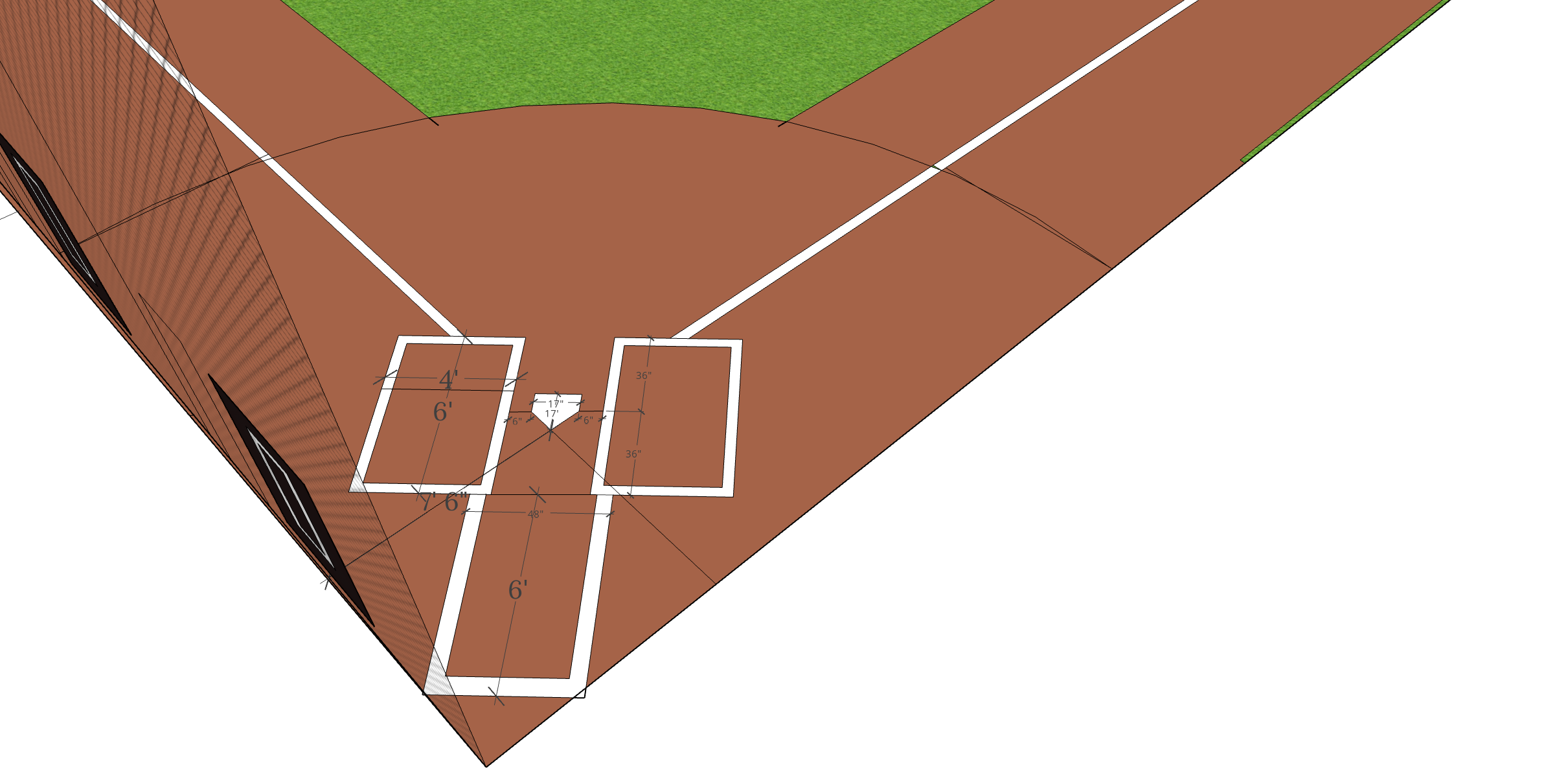How Much Space Do You Need for a Regulation Indoor Baseball Field?
Published February 22, 2024
This post is 0% AI Generated.
While it’s easy to find the dimensions of a regulation baseball, softball or little league infield, understanding the actual space required in an indoor facility is a different question. In this article, the ATXTurf design team demonstrates the spatial possibilities and limitations of indoor baseball fields. Then, we’ll explore the impact the space dimensions can have on your athletes’ ability to fully simulate real, outdoor regulation play. This will help you know how much indoor turf you will need to purchase.
Most baseball enthusiasts know that there is 90’ between the bases, and 60’ feet between the bases on softball and little league fields. But you need more room than just the baselines.
So how long of a building, or space, do you need to comfortably practice indoors?
Let’s break the measurements down into 3 parts.
- Home Plate Area.
- Home Plate to Backstop
- Home Plate to Right Field
1. The Home Plate Area
A baseball batter’s box consists of 2, 4’ x 6’ boxes (3’ x 7’ for softball), a 17” wide home plate with 6” in between the boxes and plate. The catcher’s box is a 4’ x 6’ box that extends down from the batter’s boxes. As you can see in Diagram 1, if you extend the first base line another 8 feet, you can technically fit the catcher’s box in a corner of a space, but no extra room. Let’s just round this up to 10’. So now you need 100’ length (90’ Baseline + 10’ Home Plate Area)
Diagram 1
2. Distance to the Backstop
According to the rulebook, it’s suggested to have another 60’ from home plate to the backstop on outdoor regulation high school and professional fields. Current professional field distances from home plate to the backstop range from 42’’ to 60’ with the former Yankee Stadium even reaching 73’. While the current Progressive Field in Cleveland and Chicago White Sox fields measure the full 60’, Texas Globe Life Field only measures 42’. The rest fall somewhere in between. See table below for reference:
| Team | Stadium | Distance from Home Plate to Backstop (in Feet) |
| New York Yankees | Yankee Stadium (2010) | 73 |
| Chicago White Sox | Guaranteed Rate Field | 60 |
| Cleveland Indians | Progressive Field | 60 |
| Anaheim Angels | Angel Stadium | 56 |
| Milwaukee Brewers | American Family Field | 56 |
| Seattle Mariners | T-Mobile Park | 56 |
| Arizona Diamondbacks | Chase Field | 55 |
| Chicago Cubs | Wrigley Field | 55 |
| Detroit Tigers | Comerica Park | 55 |
| Baltimore Orioles | Camden Yards | 54 |
| San Fransisco Giants | Oracle Park | 54 |
| Toronto Blue Jays | Rogers Centre | 54 |
| Atlanta Braves | Truist Park | 53 |
| Los Angeles Dodgers | Dodger Stadium | 53 |
| Oakland Athletics | RingCentral Coliseum | 53 |
| Boston Red Sox | Fenway Park | 52 |
| New York Yankees | Yankee Stadium 2 | 52 |
| St. Louis Cardinals | Busch Stadium | 52 |
| Pittsburgh Pirates | PNC Park | 51 |
| Cincinnati Reds | Great American Ballpark | 50 |
| Colorado Rockies | Coors Field | 50 |
| Miami Marlins | LoanDepot Park | 50 |
| Philadelphia Phillies | Citizens Bank Park | 50 |
| Tampa Bay Rays | Tropicana Field | 50 |
| Houston Astros | Minute Maid Park | 49 |
| New York Mets | Citi Field | 46 |
| Kansas City Royals | Kauffman Stadium | 45 |
| Minnesota Twins | Target Field | 45 |
| San Diego Padres | PETCO Park | 45 |
| Washington Nationals | Nationals Park | 45 |
| Texas Rangers | Globe Life Field | 42 |
Source: Clem’s Baseball. www.andrewclem.com
In order to achieve a full 60’ behind home plate, you would have to extend the 90’ first and third baselines another 40’ to the walls (See Diagram 2), in order to achieve 60’ behind home plate in the corner. This does include the home plate circle. So you need 130’ (90’ for baseline + 40’ to backstop walls).
Many high schools and colleges only have 20 to 30’ behind home plate. In this case, in Diagram 2, you would need to extend the first and third baselines another 20’ past home plate in order to achieve a point of 30’ behind home plate in the back corner of the space or building. In this case we are at 110’. (90’ for the baselines + 20’ for the backstop walls.)
Diagram 2
In reality, some high schools with space limitations have almost NO distance between the catcher’s box and the backstop. In these cases, runners are more likely to get thrown out by the pitcher after the ball bounces back than to get tagged out at home by the catcher. If your high school or local fields have this situation, then maybe you should practice with very little distance behind the catcher’s box, in which case we are back to a measurement of 100’ in length. (90’ Baselines + 10’ Home Plate Area) not including the distance after first base.
3. First Base Line
Just like we need space behind the catcher’s box, we also need some space past first base. You can’t have a wall only 2 feet, for example, after first base as that leaves no room for the first baseman to maneuver, or for the runner to run full speed through first base, or rounding it, defeating the purpose of replicating an infield for many at bats. The distance from first base to the right field edge of the infield is dictated by a circle with the pitching rubber at the epicenter and a radius(distance from center of circle to edge of the circle) of 95’. The point at which that circle intersects with the right field foul line is 40 feet past first base. Again, See Diagram 2.
If you want to fully replicate a regulation pro field, you would need about 170’ along one edge for the first baseline (90’ for the baseline + 40’ to the backstop (for 60’ behind home plate) + another 40’ after first base to the right field edge. In reality, most high school and college kids don’t need a full 60’ because even most major league fields don’t. Perhaps 25’ is an ideal compromise, reasonably giving your catchers and runners plenty of room. And maybe you don’t need the full 40’ of clearance after first base for runners and can get away with 20′ with some padding on the walls. This will, however, limit the range of playability for the first baseman. In this case, you would need a length of 125’ (90’ for the baseline, 15’ for the Home Plate area, and 20’ for after first base) 125′ x 125′ is doable but will limit the range for infielders.
The same measurements for the first baseline also apply to the third baseline, however, less space is needed past third base for runners, but the same measurement of 40′ would apply to the left field edge with a 95′ radius from center, if you really wanted to replicate a full infield for a third basemen.
If you want the full, regulation infield experience in an indoor facility, then you really need a 170′ x 170′ space to accomodate the full range of motion for the first baseman, the second baseman, third baseman, catchers and base runners.
If you are searching for the ideal building for an indoor facility, keep these measurements in mind and understand what you can and can’t do on the field within the dimensions. If you already have a space, perhaps these measurements will help you think through the layout of the facility. Instead of locking yourself in with inlaid clay colored turf, maybe you are better off with all green turf and placing the bases where and when you need, for different situations.
In the case of little league or softball infields, simply substitute the 90’ used in these calculations with 60’. The radius to the outfield is also less, which we may address is in a separate article.
As always, feel free to reach out to a rep at ATXTurf for further questions and quotes. 866.428.2809



Great post! I was wondering how much space I’d need to install a regulation indoor baseball field for my kids’ team. Your information was super helpful, thanks for sharing!
I’m a volunteer coach for a local youth baseball league and we’re looking to install an indoor field for our winter training sessions. Your article provided really helpful insights on the space requirements. We’re currently considering installing a turf field and I was wondering if you could recommend any specific ATX Turf products that would be suitable for an indoor field?